The transportation agencies at the City of Portland and the State of Oregon want users of bicycles to have more success in triggering green lights at intersections.
At ODOT there’s concern that the passage of SB 533 might create dangerous situations. That bill, signed into law by Governor Kate Brown on May 21st, allows people riding bicycles and motorcycles to proceed through a red light if they’re undetected after one cycle. At PBOT, they also want to increase the number of people who know how to trigger green lights after a 2013 study showed half of Portland’s bike riders don’t know how to use the existing sensors.
To help with their education campaign, ODOT has created a new brochure (and posted it on their Bicyclist Safety webpage). ODOT Active Modes Traffic Engineer Gary Obery shared it with us yesterday.
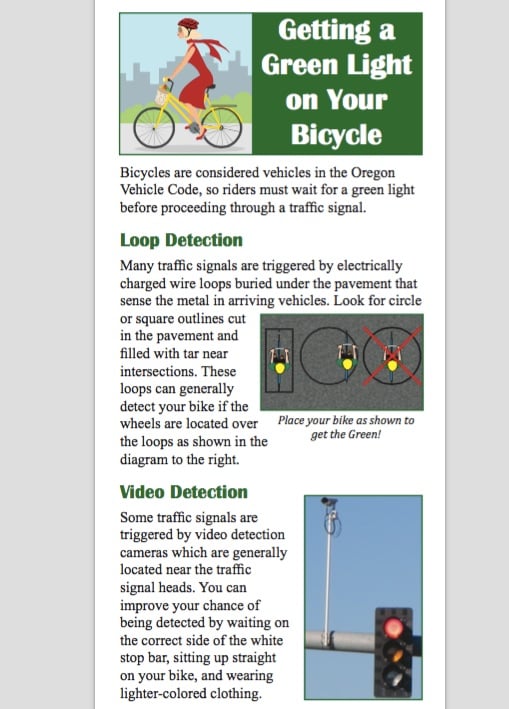
ODOT’s worried that the new law creates unpredictable situations and that some riders will make poor decisions about when it’s safe to proceed through a red.
“With the passage of SB 533,” Obery said via email, “people on bicycles may be tempted to wait one cycle of the traffic signal and then, if they haven’t received a green, cross the intersection against a red light.” (That behavior is exactly what the law allows.) What Obery would rather have people do is get the existing signal sensor to detect their presence.
Advertisement
Obery’s concerns echo testimony given by ODOT Traffic Safety Division rep Amy Joyce to a Senate Committee during consideration of SB 533 back in April. Joyce voiced serious concerns that the law would create unpredictable and dangerous situations. Instead of going through a red, she said a better option would be to do a two-stage turn (a.k.a. a “Copenhagen Left”) or push the walk sign button.
The Governor’s Advisory Committee on Transportation Safety opposed SB 533 on similar grounds. Instead of “seeking permission to run red lights,” their rep said at that April committee hearing they preferred a complaint-driven system where people on bikes and motorcycles would call a hotline and ask ODOT to adjust sensors. “We fear inexperience and peer pressure could be fatal for bicycles and motorcycles,” the rep said.
The law passed despite these concerns and objections, so now ODOT is in education mode in advance of it becoming effective on January 1, 2016.
Their new brochure offers three main tips to “get the green”:
- Loop Detection: Many traffic signals are triggered by electrically charged wire loops buried under the pavement that sense the metal in arriving vehicles. Look for circle or square outlines cut
in the pavement and filled with tar near intersections. These loops can generally detect your bike if the wheels are located over the loops as shown in the diagram to the right.- Video Detection: Some traffic signals are triggered by video detection cameras which are generally located near the traffic signal heads. You can improve your chance of being detected by waiting on the correct side of the white stop bar, sitting up straight on your bike, and wearing lighter-colored clothing.
- Other Detection Hints: The signal does not “remember” that it detected you, so stay in the detection zone until you get a green light. If you have waited for more than two minutes, consider moving over to allow acar to move into a detection zone or go to the sidewalk and press the pedestrian push button.
As for PBOT, you might have noticed their latest education efforts out on the street. At NE Tillamook and Martin Luther King Jr Blvd (in photo above) they’ve unveiled a new symbol meant to communicate where your bike should go in order to trigger the sensor. This symbol is an updated version of others you’ve probably seen around town and it’s just their latest effort to make their signals more responsive to people riding bicycles and encourage more compliance with the law.
— Read our 2010 story, Bike Science: Making sense out of signal sensors to learn more about getting the green.


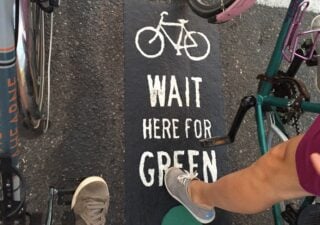
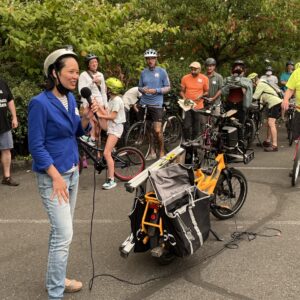
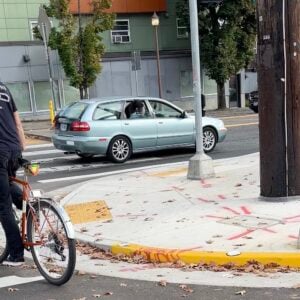
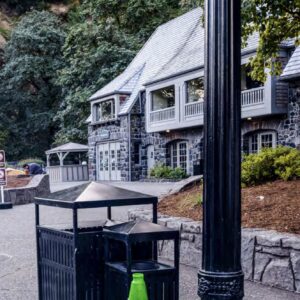
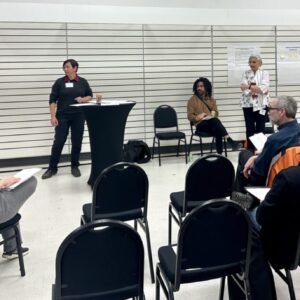
Thanks for reading.
BikePortland has served this community with independent community journalism since 2005. We rely on subscriptions from readers like you to survive. Your financial support is vital in keeping this valuable resource alive and well.
Please subscribe today to strengthen and expand our work.
Classic ODOT –
“At ODOT there’s concern that the passage of SB 533 might create dangerous situations.” &
“ODOT’s worried that the new law creates unpredictable situations and that some riders will make poor decisions about when it’s safe to proceed through a red.” &
“We fear inexperience and peer pressure could be fatal for bicycles and motorcycles…”
But Barbur dangerous for people biking? Nope.
I’m concerned that ODOT has already created dangerous situations. On every road they’ve touched, ever.
How are you undetected after one cycle? One cycle includes green in both directions. At intersections that are triggered, if you don’t trigger it, you won’t get the green, you sit and make a guess at how long your red should last, then make the move across when its safe.
Think of turn lanes that don’t have bike detectors, and MUP that don’t pick up some bikes (Johnson Creek / Springwater).
Correct. In most cases there is no way to know how long “one cycle” actually is. I suppose you could count 120 seconds and then go, since that is at the upper end of cycle lengths (most signals in Portland are between 50 and 90 seconds).
The Governor’s Advisory Committee on Transportation Safety opposed SB 533 on similar grounds. Instead of “seeking permission to run red lights,”
“We fear inexperience and peer pressure could be fatal for bicycles and motorcycles,” the rep said.
These statements truly show how out of touch and how little common sense these law makers and their “advisory” committees have. How stupid do they think people on bikes are? wait.. don’t answer that.
I realize politicians think they pool the wool over our eyes on all sorts of things but their line of thinking is just stupid.
Now, once this law is active we should really start lobbying for a “Portland stop law” (similar to Idaho stop) that will allow us to legally do what most riders already do which is not completely stop at stop signs and treat 4 way stops as yields.
With the amount of Greenways that we have which are unique to Portland we should also have a law that allows a similar approach as the Idaho stop laws to help us move through the city in Greenways more efficiently.
To be fair, they think all user are that stupid. I mean how many signs are on the road now that just say normal, common traffic laws? Examples: “Do Not pass” when there are already double yellow lines, “Left turn yield” when left turns should always yield, “Slower traffic keep right”, etc.
More accurately, they know that some road users are stupid. And they’re entirely right about that.
I agree that most drivers are that stupid, and that they need to be treated like 3 year olds by legislators, But. There is a difference between a carhead not heeding a “slower cars keep right” sign (witch is very subjective to the conditions) or left turn yield signs since the level of risk is usually very low.
Whereas a cyclist deciding to make a left turn from a red light isn’t just going to jump into traffic just because the law says they can… which is what those Advisory committees were implying.
But the reality is its a pretty high risk action so most cyclists will be vigilant
Quite the generalization!
Strange! Idaho stops were initially requested by the Idaho state Police. once they did this the “Crash” rate between cyclists and motorists went down. Of course this made it so the cyclist was a little more responsible for his or her own safety by learning to look, listen and think.
I think “Wait Here for Green” will be confusing now that pot is legal. Do we really want people standing the streets looking for a toke?
Those pavement markings won’t last very long when people drive over them constantly.
They are in the middle of the lane.
Actually, they’re usually closer to the edge of the lane because the marking is over the spot of the tangent of a bike’s direction and the loop’s circle. So it’s most often somewhere within a couple of feet of the right edge of the lane.
The one at Tillamook and MLK (possibly the one pictured) is exactly where people in large trucks like to put their right tire when waiting for the light.
The MMA markings on 57th at Sandy are lasting quite well.
I didn’t know there were any mixed martial arts studios out there.
It would be nice if the new marking was an *enhancement* of the conventional marking. So people would learn from the new one how to recognize the conventional, nationwide marking…
Just sayin…
Ted Buehler
Jonathan’s link, copied below, shows the conventional marking…
http://bikeportland.org/2013/11/13/study-half-of-portland-riders-dont-know-how-to-trigger-green-lights-97021
It’s important to have consistency…
Doubt it? Try riding up N Williams, where there is much more space for bikes than before, but a distinct new danger is that most intersections are configured differently than the ones before or after.
The one at Tillamook and MLK (possibly the one pictured) is exactly where people in large trucks like to put their right tire when waiting for the light.
Now that’s thinking!
I’m surprised at the number of people I see on a daily basis which don’t know how to use the “wait here” line or the basics of loop detection triggering with a bike. But then again, this is all relatively new technology and there has been little effort to help people understand.
I do teach people who don’t know and I welcome ODOT and any other agency which help spread the word so we can all get around more quickly.
It (the loop unadorned by any text or signage) is anything but intuitive. I only learned how to do it by reading bikeportland comments.
I agree that it’s not at all intuitive. I frequently come across cyclists waiting at the far right of the road, hoping the light will change. I often explain to people that they need to wait at the bike symbol, and it’s a complete revelation to them.
What did you think it was before you knew?
I knew it was a detector loop – have known that since I was a lad. But what I didn’t know was all the details of positioning. I used to ride over it, and if I remember correctly, position myself inside the circle.
You youngsters! When I was a lad, there were rubber pads in a metal frame, that detected the weight of the car wheels squishing two electrical contacts together !
I’ve tried to educate several riders about how to use the loop and most of them have looked at me like I’m insane. I had one guy insist I was wrong and then proceeded to sit through two cycles of lights before sheepishly moving over and triggering the light. It makes me wonder if my day today conversational skills are terrible and no one has ever told me….
The new explicit symbol will be a big help to those ignorant on how to trip the loops. When I’ve offered to people waiting entirely outside the loop that they need to be over the old-style symbol, they look at me like I’m crazy and/or rude for talking to them.
In time, people should learn to trip them even when there is no coaching symbol.
As an aside, I’ve notice a lot of small diamond loops that are used in bike lanes are often more than halfway outside the bike lane (wb N Broadway at Larabee for example: https://goo.gl/maps/u6dMJ). Wish PBOT would fix that.
Problem is, as I understand it, loops only work when the bicycle in question has a certain amount of ferrous metal in it. Carbon-fiber, aluminium, and titanium bicycles generally will not contain enough ferrous metal to trigger the loop, no matter where the bicycle is positioned on top of it.
So, what about folks with non-steel-frame bicycles? Are they just supposed to run the red, under the new law?
Incorrect. You don’t need ferrous metal. Just amy metal (inducing aluminum). Enough to disturb the electromagnetic field: http://bikeportland.org/2010/09/27/bike-science-making-sense-out-of-signal-sensors-39517#comment-1634417
I think rim material is more important than frame material. And a ferrous metal is not required.
There are plenty of carbon rimmed bikes out there that may have trouble triggering even quite sensitive sensors, however.
i love the road feel of my carbon disc wheels and also like the fact that they have a much lower CO2e than aluminum wheels.
“In time, people should learn to trip them even when there is no coaching symbol.”
OR, the signals should detect any vehicle stopped behind the stop bar without requiring special “coaching”, tribal lore, science experiments, or an SUV to make it work.
A really essential element that is missing from almost all such detection systems is ‘positive feedback’ (sound or light) to let cyclists know that they have been detected. Much of the frustration and uncertainty comes from not knowing for sure that the system will act in accordance with your presence. A very simple bit of technology that usually exists at intersections for pedestrian push buttons. Really just need to link the two together. But almost no one does. Why this oversight?
Excellent point!
Never fear. More and more of these are popping up for just that reason. I love it when an intersection has the blue light.
Thanks for digging that up. Johnathan should bring that up again. I was wondering what those blue lights are! It was evident they had something to do with the signal, but I couldn’t pinpoint it. An optical sensor? A cycle counter? Finally the answer: a loop indicator.
The other day I noticed the blue indicator light for the bike signal for entering Rose Quarter from the Eastbank Esplanade has been removed and some sort of countdown display has been added.
There are several locations now that do have this positive feedback for bikes. Look for a little blue light up by the signal. The MLK/Tillamook signal has one.
induction loops do not detect aluminum or carbon fiber bikes. You can be in the right spot and still not trigger anything…
The axles on your pedals are bound to be steel. How about your bottom bracket? Spokes? Eyelets on our shoes? Bolts holding your fenders to the fork and frame?
They do detect aluminum. The metal does not have to be ferrous to trip the detector, but the detector does need to be tuned right.
There are a few of these on the Orange Line MUP, but they are painted green instead. I think I like that design better. They are positioned so that you are forced to roll over them, so that you are detected no matter what.
Instead of “this is how to be detected by the car detectors”, why not install more bike-specific detectors with the blue lights?
except that you still need a green light to cross the intersection to make that right to wait to go straight again across another intersection you’ll need a green for…
so are they saying we should be ignored by 2 lights instead of 1?
how many people had trouble learning how to get their car to trigger the light when they first learned to drive? why won’t they just do it right for bicycles so they don’t need to educate people?
it’s obvious they don’t know AND don’t care about bicycling…
“If you have waited for more than two minutes, consider moving over to allow acar to move into a detection zone or go to the sidewalk and press the pedestrian push button.”
If you have waited more than two minutes, you probably don’t care how long its going to take to get where you’re going.
My parents tought me to look both ways and if it’s clear go…
It’s been working for me for 30+years and no accidents on a bike..
But granted there are a lot of streets/intersection I will take my time and wait for the signals or hit the Beg Buttons…
Glad to hear, I get mixed responses when I point them out to people that are unaware of their function.
Now if we can only get “bikes ride here” under those sharrow/greenway markers. Which would get people riding bicycle out of the dooring lane position – or worse leapfrogging parked cars, and at the same time educate drivers of where a bicycle should be in those lanes.
Amen.
BTW – this doesn’t make sense:
a.k.a. a “Copenhagen Left” where you turn right, then straight to go left.
Not sure how turning right and then going straight accomplishes a left turn, that description potentially makes for a very long bicycle ride.
Though now that I think about it (and a couple efforts at it), it’s kind of hard to verbally describe well- pictures of it are much better.
I know most people here know what the “Copenhagen left” is, but there are people that might not get it with the given description.
ON my ride home, I take a left from N Interstate on to Overlook. There was a very faint bike symbol on the far edge of the loop, and it placed you pretty close to the MAX train. They recently painted a new symbol, but it is way to the right, and uncomfortably close to cars (who are frequently driving half way in the turn lane if no cars are present. Can anyone tell me if one can trigger the signal from anywhere on the loop (as long as metal is over the edge of the circle?) I had numerous close calls and will now run the light rather than take my chances by hanging out so close to motor vehicle lane.
The reason why the indicators are on the left or the right of the loop is because that is the best position to get both your wheels on a part of the loop. But as long at the bike frame and/or wheels are aligned on some part of the arc of the loop, it will get a read off of you.
Thanks John! Looking forward to trying to trip this with my bottom bracket over the top of the circle!
Since we’re already deep in the weeds here, does anyone reading this know what is the minimum time one must hold one’s metal over it? How close? Peter Koonce?
See what I mean, davemess? This isn’t so intuitive.
Based on what I’ve seen at NE Knott at MLK (where there’s a blue light indicator), it’s pretty instant on or off as far as being recognized. Approaching MLK on Knott (wb) if there’s no cars there already, I can see the light flick on and off as I cross over each loop and until I stop at the final position over the edge of a loop and then it stays on.
You have to “hold your metal” until your signal turns green. If you leave the detection zone, your signal request is “canceled”, AFAIK. That’s why when I’m waiting in a left turn lane undetected, and car after car pulls up on my right, then makes a right turn on red, the signal stays red. Somebody has to stop and stay stopped over the loop to get a green.
I think the article says you have to stay continuously over the loop or the detection goes away. That’s my experience at Ladd and Division southbound.
What was a bit confusing was at 21st and Division, northbound, where there’s a bike box, the “wait here for green” marking is not in the bike box, but over to the right, near the curb. So, we’re being told NOT to use the bike box to get in front of cars?
It may be because the only bike specific small rectangle detectors are over by the curb. In the middle of the bike box are the large loops. So, is this a case where the loops were put in wrong? Is PBOT not putting the bike-specific rectangle loops in the bike box deliberately, or is this an evolving standard?
RE: Video Detection: “You can improve your chance of being detected by waiting on the correct side of the white stop bar, sitting up straight on your bike, and wearing lighter-colored clothing.”
Ideally, video detection would always detect cyclists. But in my experience these are only initially set up to detect cars, and are changed only when we complain about it. And even then, you are only ‘improving your chances’ by standing in the right spot and wearing the right stuff.
Have you managed to get a green signal to cross Bethany at Oak Hills any time recently without a car to wake up the video or a ped to push the button? I used to get much better detection by the embedded loop at Bronson, but now that has started failing me as well.
I can’t recall….seems like we always had to wait a while, long enough for cars to show up behind us.
I used to ride that way with the kids. But I’ve been afraid to try it lately, because last time my 6-year-old barely made it across in time before the light changed. Guess I’ll have to go back by myself and check it out.
“…last time my 6-year-old barely made it across in time before the light changed.”
This is the other thing—even if we can get a green, if I or someone in my party has a 0-60 time of infinity, it is very difficult to get across an intersection in the 3 seconds or so of the green cycle. In full drag race mode, I haven’t yet managed to get all the way across Bethany at Bronson before the yellow. If I’m going to wait two full minutes to even get a signal, at least give me ten seconds to get across.
It would not surprise me at all to learn that the developers in our commissioner’s ears had some say in the timing & priority of the lights on Bethany. I don’t know of another intersection where the proportion of red light to green light is skewed that much.
At 118th & Cornell, I could never set off the light with their video detection. So I asked them to fix it, *twice*. I can set it off now, but I have to line up my front tire with a certain oil spot on the far right of the left turn lane or it doesn’t work. Too far forward or backwards and it doesn’t work. Only *I* know the location of the super-secret oil spot.
Meanwhile, car drivers just stop at the line, and everything works, whether it’s a loop or video detection.
How about a new kind of arrangement that embeds an array of detectors that will pick up a bike no matter where they are laterally positioned? If I forget to wear my “light-colored clothing” some day, what hope do I have of video detection? What possible measures could transpo agencies take to improve video detection of bicyclists in left turn lanes? When are pedestrians and bicyclists going to get streets that work for them, and car drivers have to roll down their windows to push buttons or align their tires just so on the pavement?
Roads may not be built for cars, but traffic light sensors sure are.
I wish I could draw cartoons…
What if bicyclists had special rules for other things…?
How to Get Movie Tickets “On Your Bike”:
Bicyclists sometimes want to see a movie just like regular people. Here’s how to be sure you can get tickets to that movie you’ve been wanting to see. First, be sure you occupy and maintain a central position in the ticket line; otherwise, other moviegoers might try to take cuts in front of you. If someone does take cuts, don’t confront them—it’s better to miss the previews than risk angering another line user. When you eventually get to the ticket window, remember that sometimes the cashier won’t see you; wear bright colors and use a light for greater visibility. If the cashier still doesn’t see you, a cheerful wave and a ding of your bell (or a call of “at your window”) should get their attention. Once they see you, be sure to speak very slowly and clearly, because oftentimes, the cashier won’t understand what you are trying to do. Usually you can help the cashier understand by pointing to a poster for the movie you want to see, or acting out a well-known scene from the trailer. Eventually the cashier should recognize what you are trying to do and get you your tickets. Finally, remember that as a bicyclist, you must carry exact change at all times, as you are required to avoid impeding the flow of the line. Just hand the exact amount for your tickets to the cashier, and you’re on your way!
——-
How to Use an Elevator “On Your Bike”:
As a bicyclist, you may sometimes find that you need to use an elevator. This is tricky, but with some practice, it can be done. As you approach an elevator or bank of elevators, be sure to signal your intentions by vigorously pointing up or down, depending on which direction you wish to go. When you get to the elevator(s) try pushing the button that has an arrow matching your desired direction. Sometimes, the button will not respond to your initial push; there are a few things you can try if this happens:
1. Try pushing the button with your non-dominant hand—use your index finger, not your thumb.
2. Try pushing the button while standing further to the left or right of the button.
3. Sometimes, if you lean down and push the button with your forehead, it will register your request.
4. If none of the above work for you, stand aside and see if someone else can push the button for you.
Once in the elevator, you might have the same button problems as above. If there is nobody else in the elevator with you, or nobody else is going to your same floor, you can try a “Copenhagen Lift”. Just ride the elevator to whatever floor it stops at, then if someone gets on and pushes the button for your floor, great! If nobody gets on, and you will be left alone on the elevator, you can either get off and try to find someone to help you, or stay on and see where it takes you. Eventually, someone should be going to your floor and you can simply exit the elevator there.
——-
How to Use A Public Restroom “On Your Bike”:
Never mind…
I think taking out the sensors and making everybody push a beg button located on a post/pole on the side of the street would be a better idea than allowing cyclists to run a “dead red”. Make the street equally accommodating for everyone. Of course drivers not dressed for the weather would soon learn what forecasts are for, and might even get a little exercise in the process of getting the light changed.
As I watched a driver take an elevator down two flights of stairs next to me this morning, I was reminded of the lengths people will go to to avoid exercise of any kind.